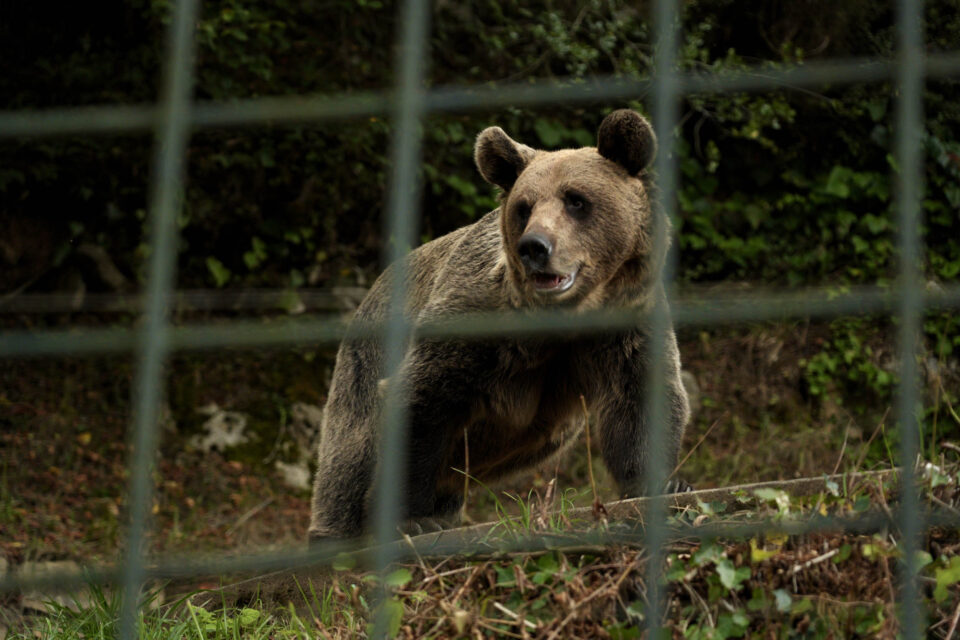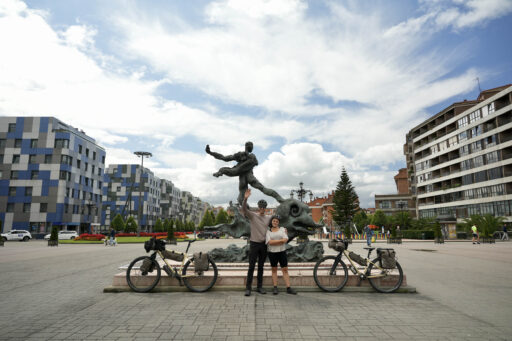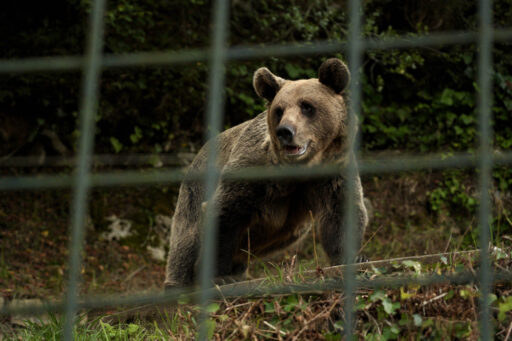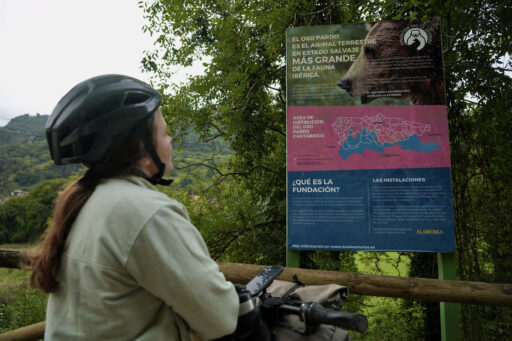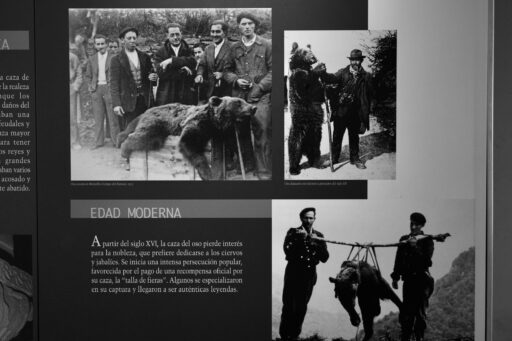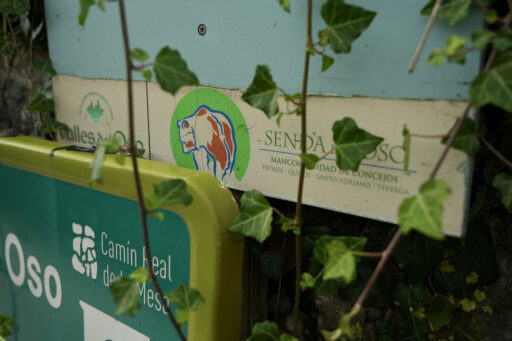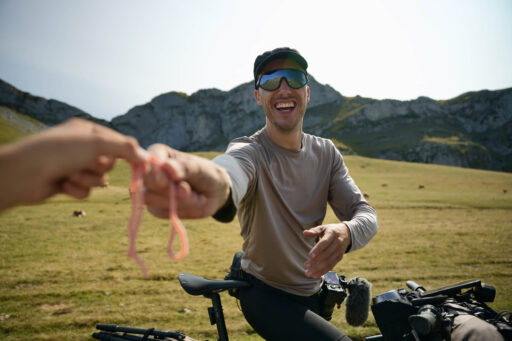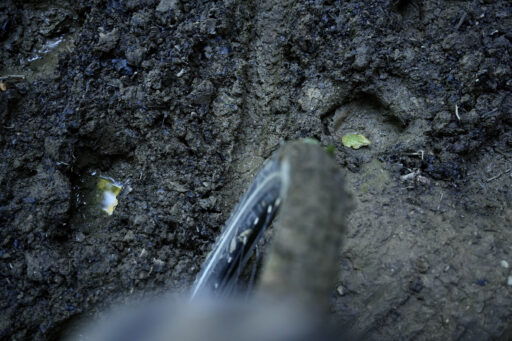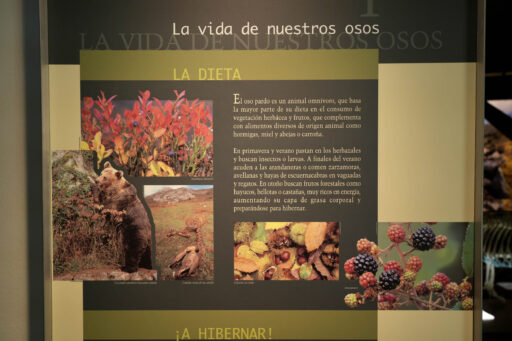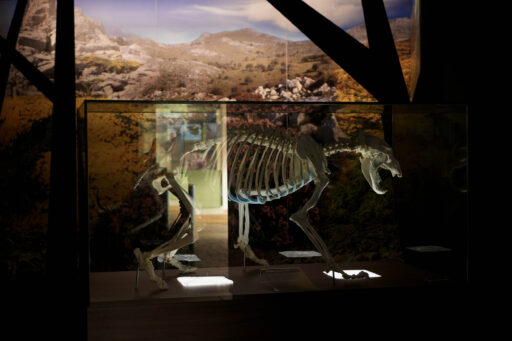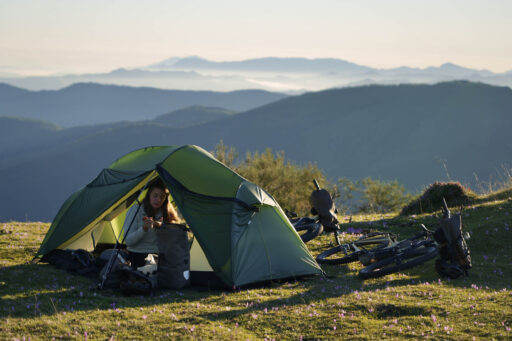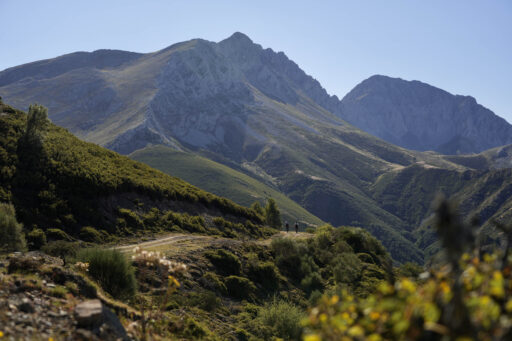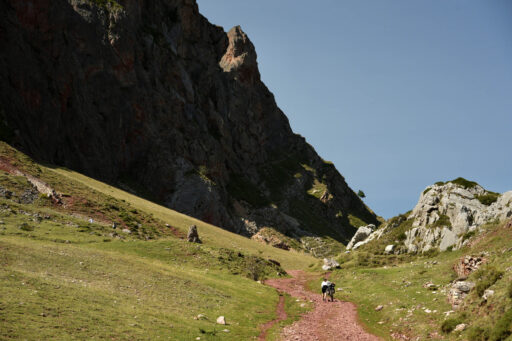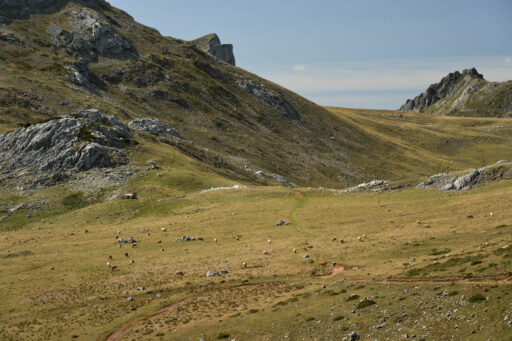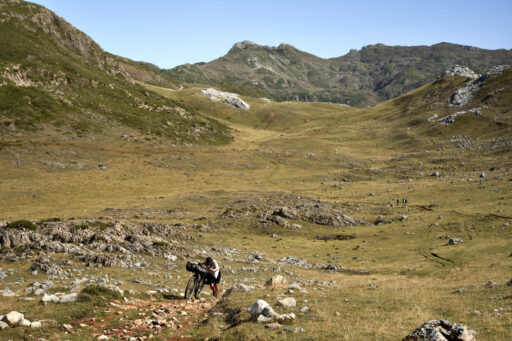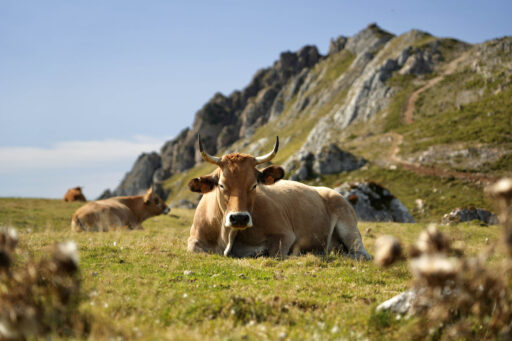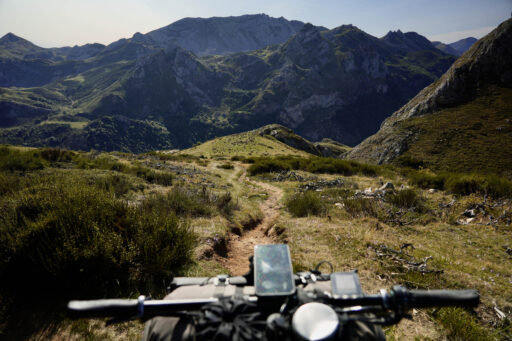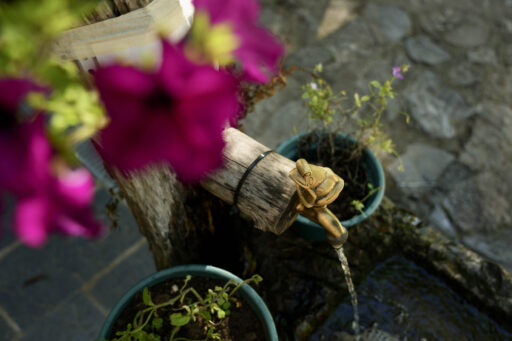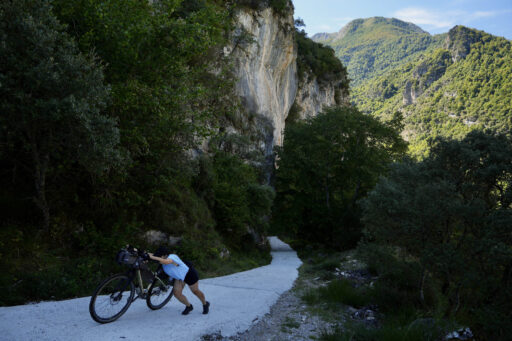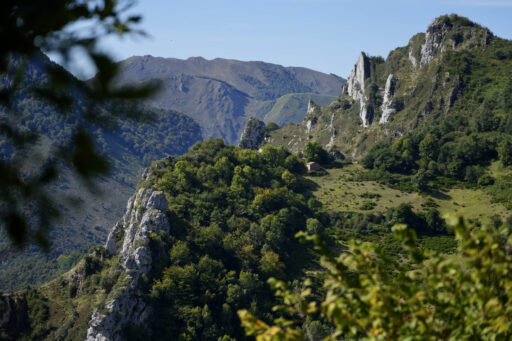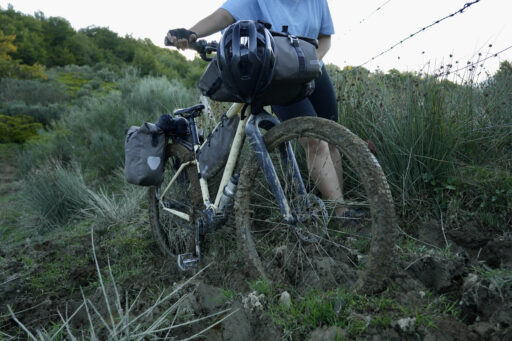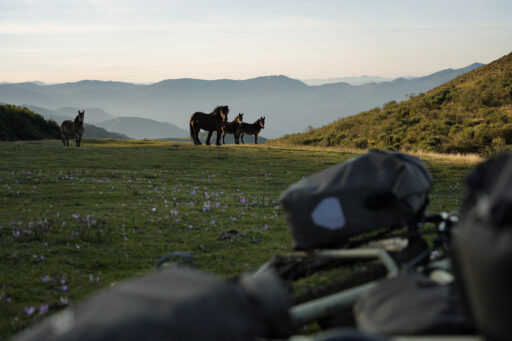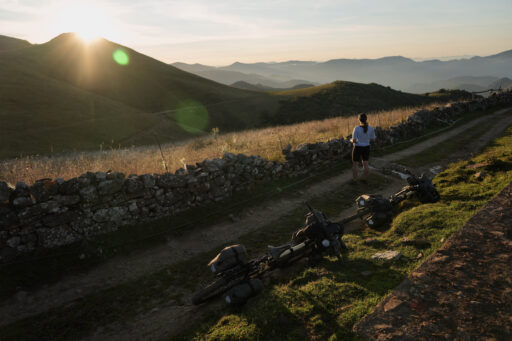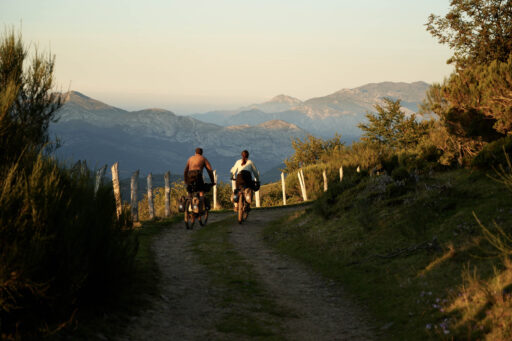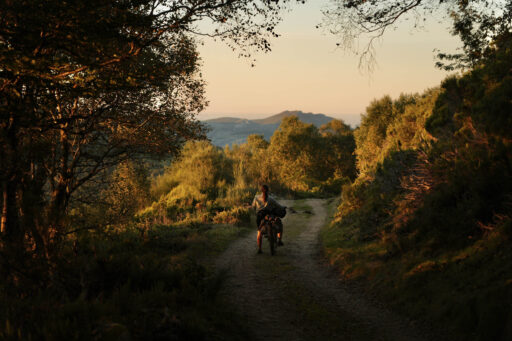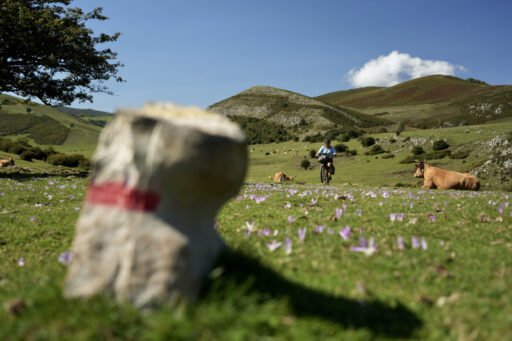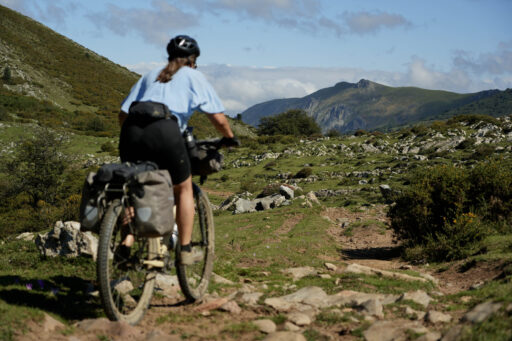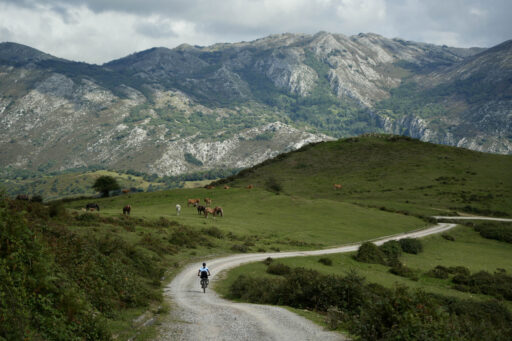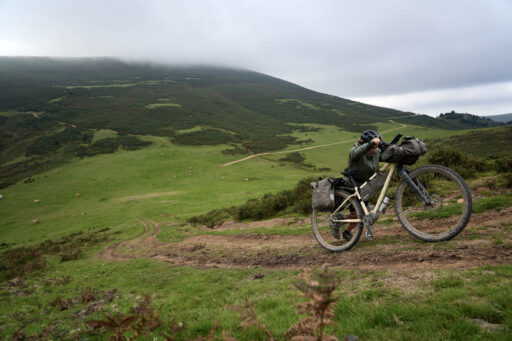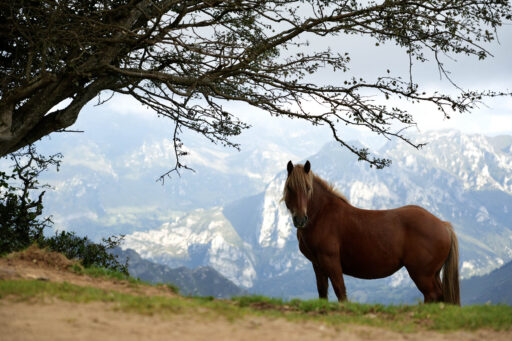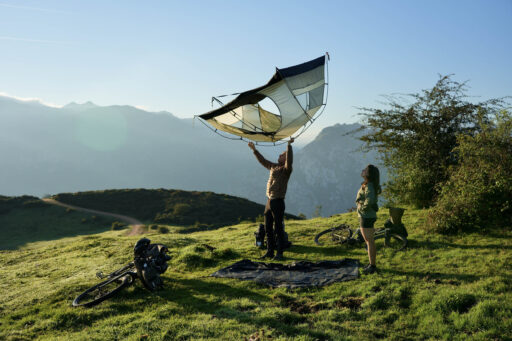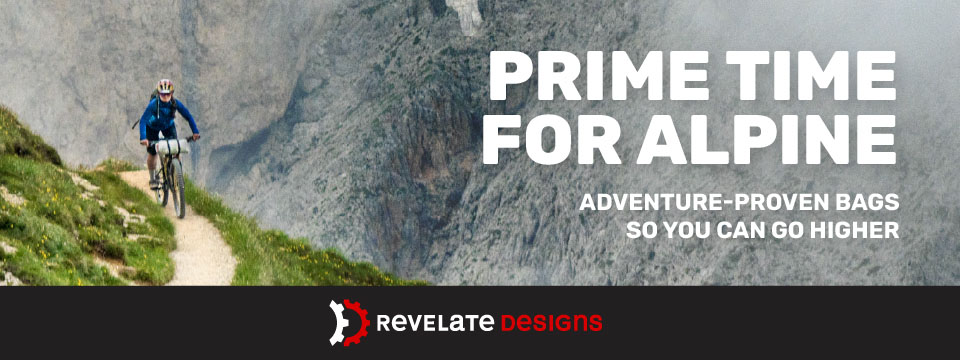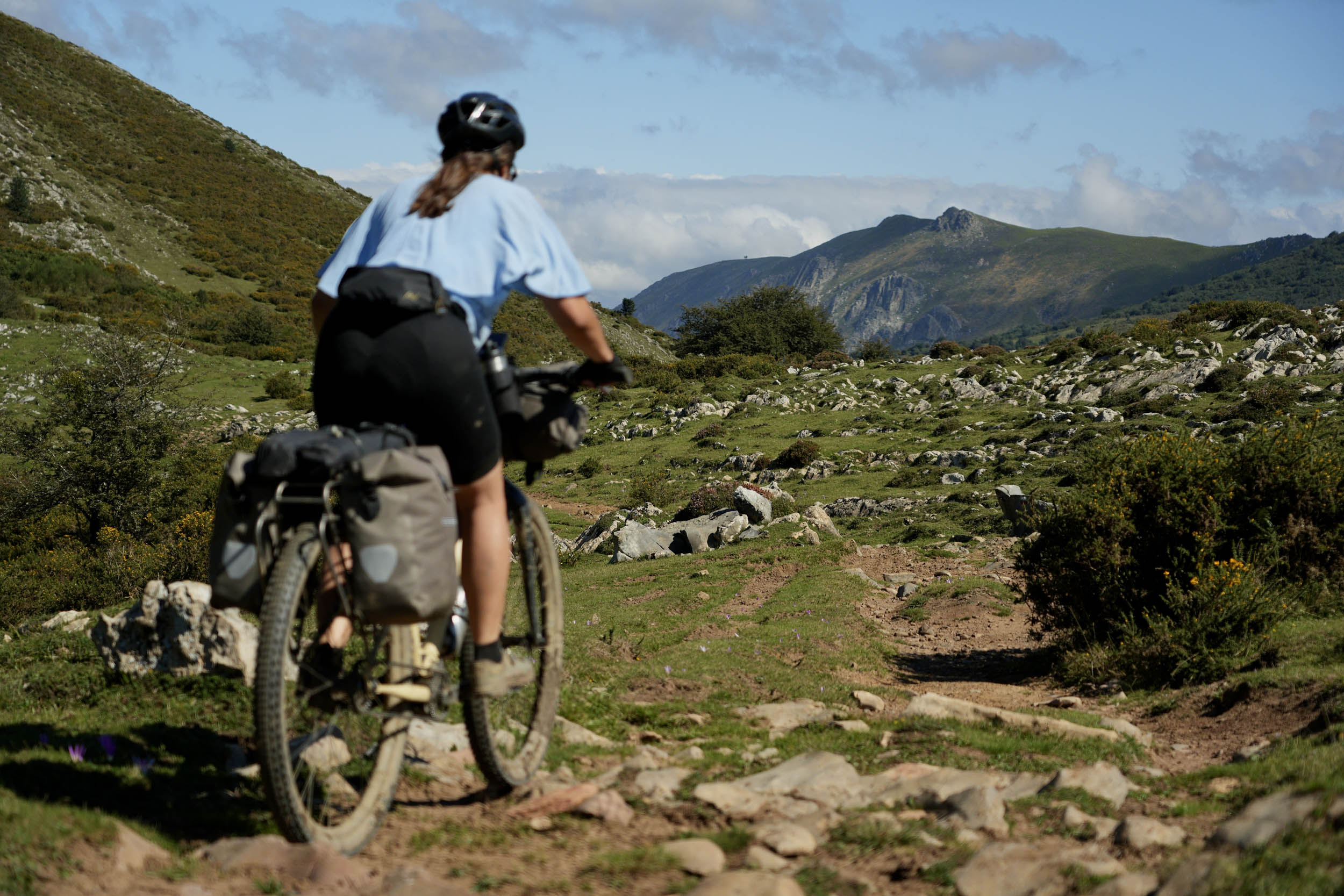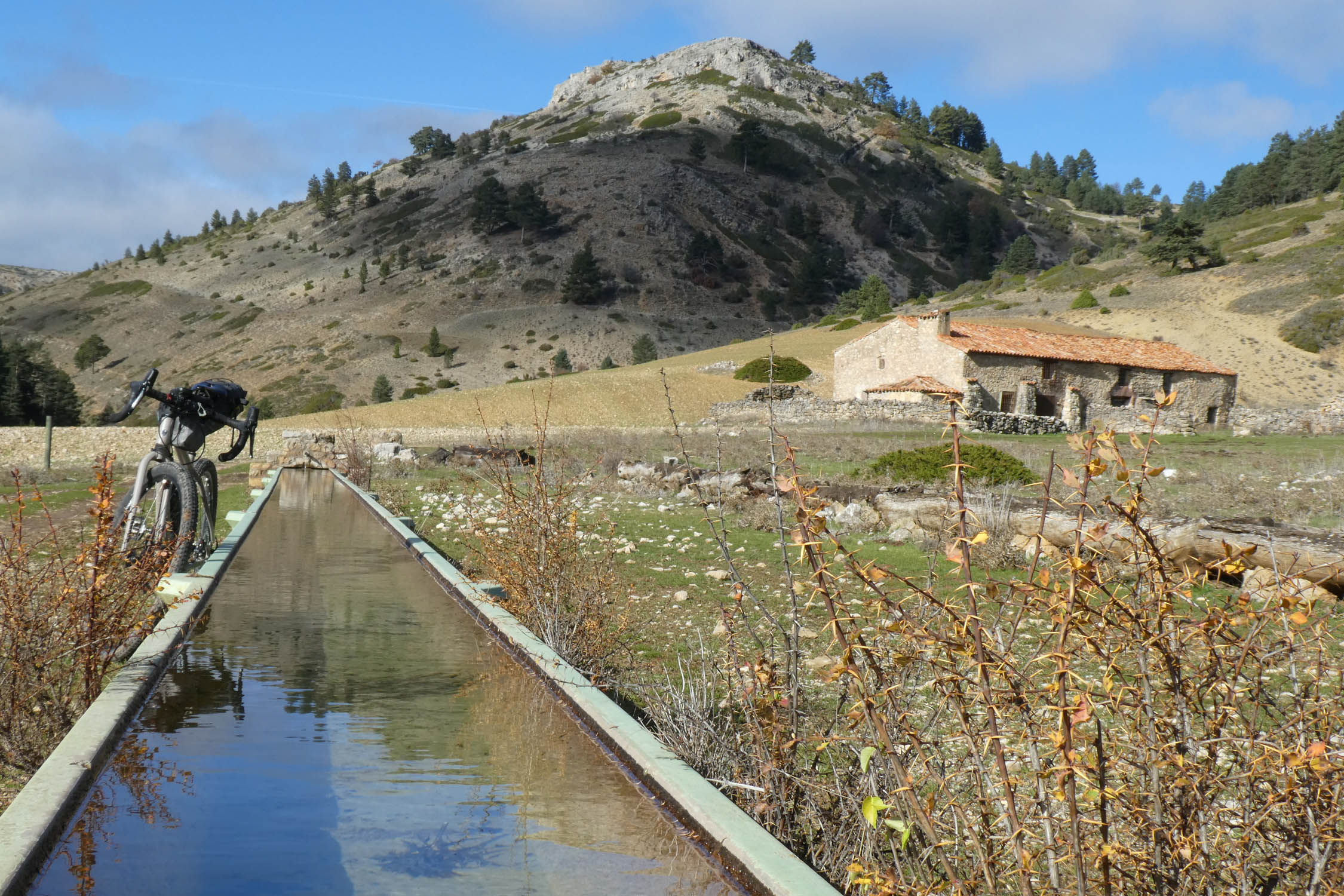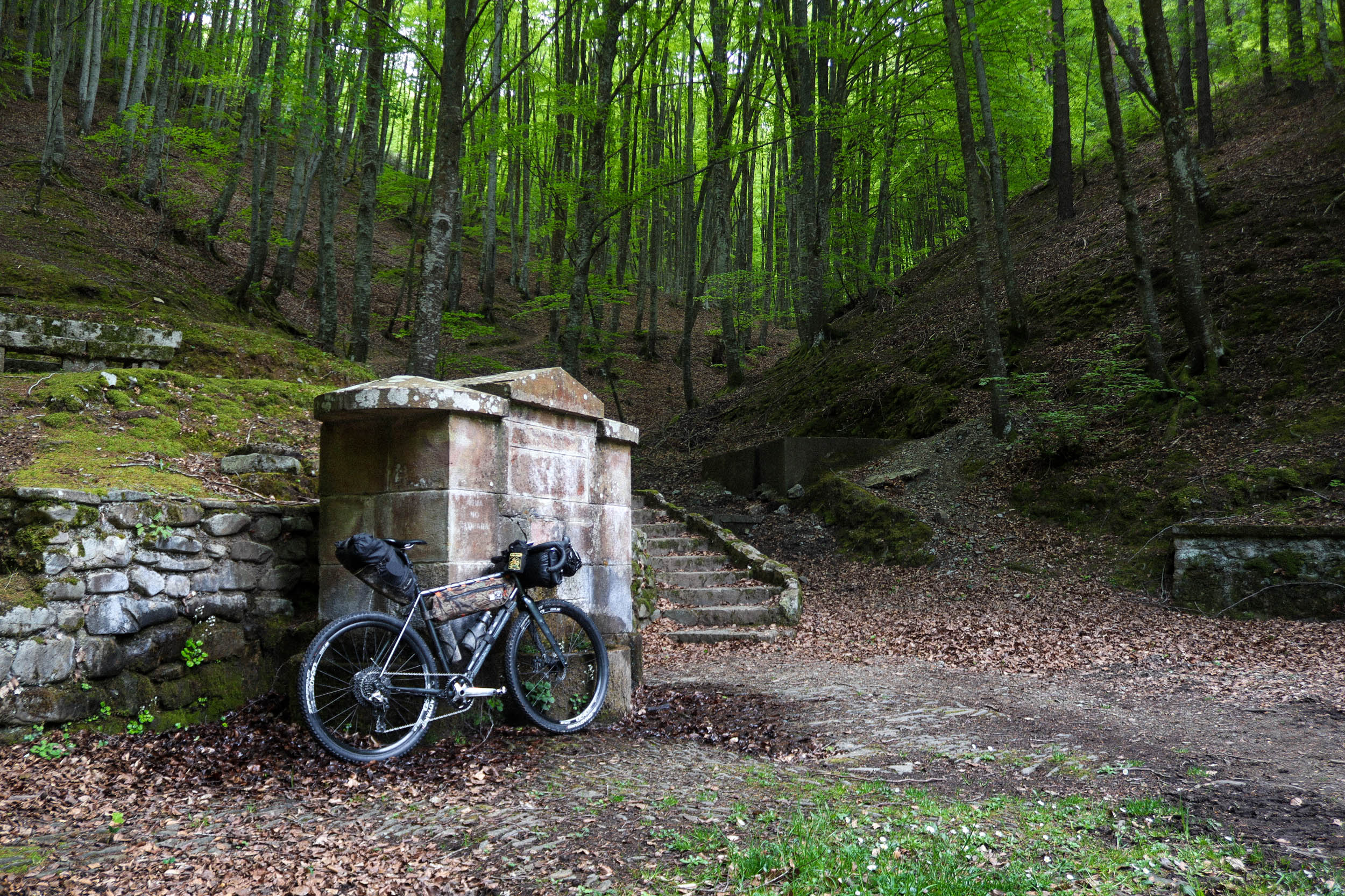La Huella del Oso
Distance
115 Mi.
(185 KM)Days
4
% Unpaved
54%
% Singletrack
5%
% Rideable (time)
95%
Total Ascent
15,525'
(4,732 M)High Point
5,800'
(1,768 M)Difficulty (1-10)
6?
- 9Climbing Scale Very Strenuous135 FT/MI (26 M/KM)
- 5Technical Difficulty Moderate
- 8Physical Demand Difficult
- 4Resupply & Logistics Fair
Contributed By
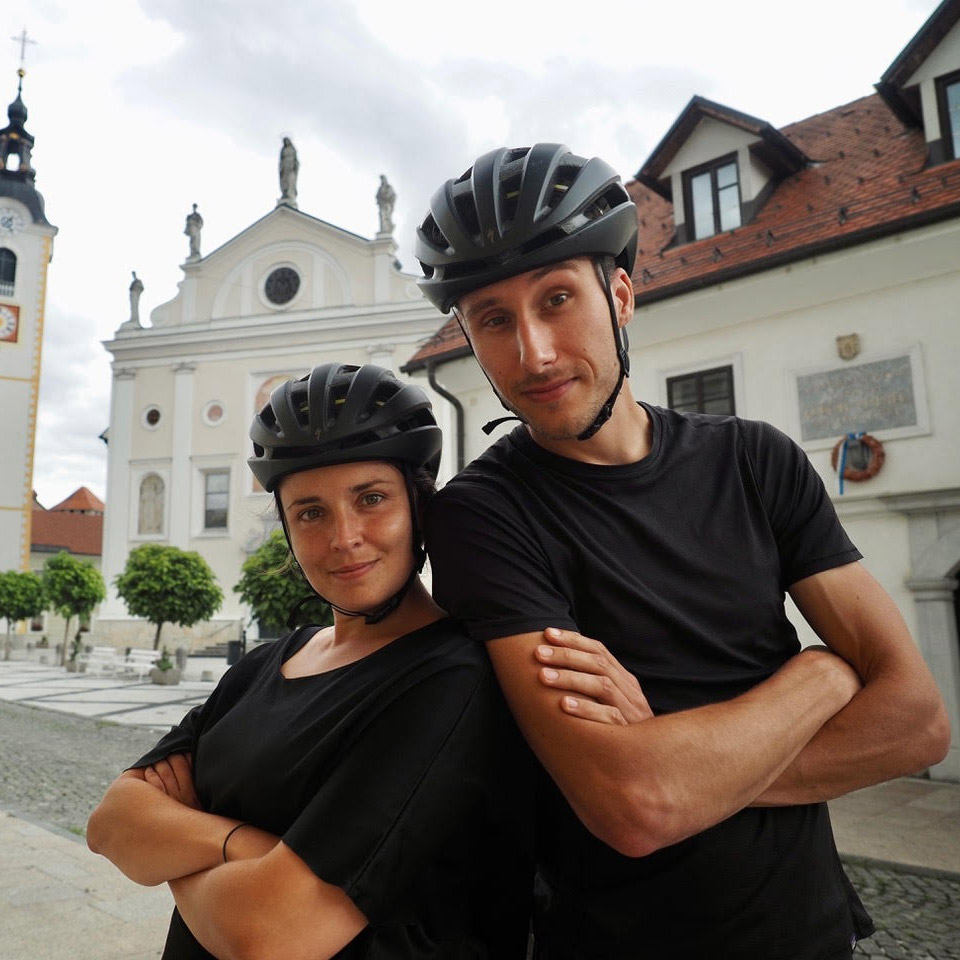
Belen Castello and Tristan Bogaard
Guest Contributor
Belén Castelló and Tristan Bogaard are an adventure cyclist couple with a taste for mountainous riding, wild camping, and ridable trails. Originally from Spain, Belén is the data-driven guide behind all of their rides, while Tristan, originally from the Netherlands, has become a bikepacking photographer through nearly ten years of bike travel. They’re the co-authors of Bike Life and 50 Ways to Cycle the World, and you can find their online work on @belletoscan and @tristanbogaard.
Belén and I first cycled the province of Asturias in the summer of 2020. We learned the story of its Cantabrian brown bears and were fascinated by the region’s natural beauty. We ended up exploring the local Senda del Oso, “the bear’s path,” that connects the capital city of Oviedo with two thriving natural parks, home to this small and highly endangered bear population. There’s mystery in these mountains, and their foggy, wet weather patterns create a unique atmosphere. Combined with the staggering natural environment and Spanish mountain culture and food, this loop offers a pleasant and adventurous way to raise awareness for the conservation of the local bear population.
For a convenient arrival and departure, the route starts and ends by Oviedo’s train station and immediately morphs into the Senda del Oso greenway, providing quick access to the Casa del Oso museum so riders can learn about the route’s theme. Just before Proaza, you may also discover the story of Paca and Molina, two cubs that were rescued from hunters who killed their mother in 1996 and failed to live without human support thereafter. This fenced habitat is under expert care of Fundación Oso de Asturias (FOA), the Asturias Bear Foundation. We encourage you to read the information panels, even if the bears are not present when you pass through.
Soon after, you’ll climb into Parque Natural Las Ubiñas-La Mesa and discover these mountains’ tranquility. Herds of cows and horses roam freely along swooping, generally car-free gravel tracks with views of far-out hamlets in the valleys. You may meet a shepherd to practice speaking some Spanish or sleep up high under the stars. Further in, you’ll enter Parque Natural de Somiedo over a high plateau that gives an almost Central Asian impression. After some singletrack, you’ll enter the pastoral Valle del Lago with a quiet, local campsite offering the opportunity to restore your energy for the second part of the journey.
From Pola de Somiedo, the route takes on a steeper profile with little to no resupply points between it and Trubia, or about 60 kilometers and 2,200 meters in overall elevation gain. The terrain you’ll ride on this stretch is significantly more challenging and could be very muddy, depending on the weather. From Puerto de San Lorenzo, you’ll follow a Gran Recorrido (GR) along the spine of the mountains northward, crossing another high plateau on which large herds of cows and horses and their companion shepherd dogs can be met. You’ll likely be completely alone up here and find that the track can be demanding, so take your time to eat, drink, and rest plenty. Up here, rushing doesn’t exist, and the cows will show you just that. Life moves slowly in the mountains of Asturias.
After passing the sleepy hamlet of Yernes, several kilometers on asphalt, dirt, and gravel will connect you back to La Senda del Oso, offering a wholesome, looped experience back to Oviedo. Now, it’s time to reap the rewards for your time spent up high. Comfortable lodging, menú del día, and plenty of cheap coffee can be found once more.
With this loop, we hope to offer a journey of reflection on humans’ relationship with nature. Over centuries, we’ve destroyed much of the natural environment with our presence, whether intentionally or not. We are used to this dominance and, most of the time, even assume it is our right to go wherever we please, the consequences of which can carve deep into the livelihood of other organisms. We encourage you to think of this when you ride the existing tracks of Asturias, reading the many information panels along the route to learn new things while practicing Leave No Trace principles. Entry to the Casa del Oso museum in Proaza is free, so pay a visit to learn about the history of the Cantabrian brown bear and the fragile beauty of their existence.
Route Difficulty
In terms of technical difficulty, we rate this route a 5/10 as the dirt roads are often smooth with some fairly easily navigable hike-a-bike sections. In physical demand, however, we expect you’ll have a far more challening experience, as the locals don’t seem to mind seemingly impossibly steep gradients for their vehicles. Expect to push your bike up a few sections of between 14-20% grades (mostly on the southwestern part of the route).
The great thing about being in Spain is that resupply is never that far out. However, the rural setting of most of Asturias can provide challenges when it comes to finding food. Several times, we were surprised to find a closed bar or restaurant, even though our map said it was open. In general, as long as you carry a day or two worth of food and snacks, you’ll be fine.
Route Development: Belén and I first discovered Asturias by bike on a larger journey across the north of Spain in 2020. When we rode La Senda del Oso, a long bike lane connecting Oviedo with its southern foothills, we decided to loop around the area to discover it further. Connecting ridable sections proved challenging in some places, and we got ourselves into a bit of a pickle hike-a-biking up trails we’ve now, four years later, routed downhill instead. Sometimes, we didn’t even know whether a trail would connect at all and took the risk of climbing up anyway. We’re both glad to have put in the days of motivated discovery in that strange 2020 summer, as it gave us the tools to properly finish the route development in 2024. You can also watch a video we made documenting the route here.
Submit Route Alert
As the leading creator and publisher of bikepacking routes, BIKEPACKING.com endeavors to maintain, improve, and advocate for our growing network of bikepacking routes all over the world. As such, our editorial team, route creators, and Route Stewards serve as mediators for route improvements and opportunities for connectivity, conservation, and community growth around these routes. To facilitate these efforts, we rely on our Bikepacking Collective and the greater bikepacking community to call attention to critical issues and opportunities that are discovered while riding these routes. If you have a vital issue or opportunity regarding this route that pertains to one of the subjects below, please let us know:
Highlights
Must Know
Camping
Food/H2O
Trail Notes
- La Senda del Oso: This old railway line, now restored as a greenway, connects the towns of Tuñón and Ricabo with several rest areas along the way. The trail passes through oak forests and small tunnels and offers stunning gorge views.
- Puente Romano de Villanueva: This small Roman masonry bridge stands in the heart of the charming village of Villanueva. It’s an ideal spot to pause for a snack and to enjoy the peaceful atmosphere.
- Cercado Osero in Proaza: Just before reaching Proaza, you’ll come across the enclosures built to support the conservation of the Cantabrian brown bear. Currently, two rescued bears, Paca and Molina, live here as they couldn’t be reintroduced into the wild. The enclosure spans over four hectares of mountain terrain, so seeing them will depend on your timing and luck!
- La Casa del Oso in Proaza: This small museum and information center highlights the history of bears and the conservation efforts of the Fundación Oso de Asturias (FOA). The foundation focuses on protecting the Cantabrian brown bear and its habitat. Entry is free, and it’s open daily from 10 a.m. to 3 p.m.
- Desfiladero de Peñas Juntas: This impressive narrow river gorge offers a striking glimpse into the passage of time, where the Trubia River has carved its path through the rock, leaving stunning cliffs behind.
- Lagos de Saliencia: These four glacier-formed lakes are the jewel of Somiedo Natural Park. Surrounded by mountains, the reddish gravel path winds around the lakes and leads up to a green plateau full of grazing cows and stunning views.
- Valle del Lago: Entering this lush valley from above is a true feast for the eyes. At the head of the valley is Lago del Valle, a dark, tranquil lake surrounded by steep rock. The valley is peaceful and preserves its traditional charm with stone houses and the working of the land by humans.
- Puerto de San Lorenzo: This mountain pass at 1,347 meters serves as a crossroads for both mountain bikers and road cyclists. From the summit, the views stretch out on both sides, and it’s not uncommon to witness a sea of clouds settled in the lower valleys below.
- La Falguera: This seasonal settlement, known as a “Braña,” still hosts seven original teitos, small stone huts with thatched straw roofs used by shepherds and their livestock. While transhumance is a declining practice, some of these cottages continue to serve as emergency shelters today.
- Collado Fancuaya: The final pass of the route reaches 1,086 meters, offering a first view of Oviedo in the distance. The paved climb transitions into soft gravel, rolling its way up and down the hills.
- Cueva Llagar: This large cavity opens up beside the trail. A dark cave, home to many bats, offers a framed view of the green valley it so beautifully closes up.
Weather and When to Go
- When to go: Asturias experiences all four seasons, so late spring, summer, and early fall are the best times to ride La Huella del Oso. July and August are the busiest months, coinciding with school holidays and the area’s growing popularity. Even at its busiest, though, this region remains relatively unknown, so you’ll likely have the trails mostly to yourself. While accommodation options are limited and may book up quickly, the upside is that most bars and shops are open, as many only operate between Easter and late September. In our experience, the route is best enjoyed between early May and late October, with June and September being our favorite months thanks to milder temperatures, lower rainfall, and quieter surroundings.
- Weather conditions: Asturias experiences mild temperatures year-round, but you should be prepared for frequent rain in any season. The coast tends to be cooler and wetter, while inland valleys and mountain routes experience more variation in temperature, particularly in winter when snow is common above 1,000 meters of altitude.
- During the summer months, temperatures can easily reach 30°C during the day, so expect hot riding conditions. The temperature can vary significantly throughout the day, and the oceanic climate creates a humid atmosphere, leading to common occurrences of early morning and late evening fog, as well as condensation.
- Regardless of the season, always be ready for unpredictable weather in the mountains!
- Check the Weather: Keep an eye on the weather forecast before heading out. If rain is expected, be prepared for muddier trails than usual. We recommend you choose shoes with good grip to help you navigate slippery surfaces.
What bike
- While you could technically ride it on a gravel bike, the best bicycle to ride La Huella del Oso with would be a rigid mountain bike.
- A hardtail would add some softening through front suspension, but the real focus should be on your tires.
- We recommend bringing at least 45mm tires so you can ride the worst and not be bothered by them on asphalt.
- A wide, flat handlebar will help you navigate the narrower rocky sections, but since most of the route consists of (un)paved bike lanes, doubletrack, and only some singletrack, even a drop handlebar should do.
- As for gears, the lower the better. There are plenty of pesky steep climbs on the route, and you’ll be thanking your cassette/gear hub/gearbox for those extra granny gears.
Travel basics & logistics
As part of the EU, Spain is easy to travel in and out of on the ground with open borders. If you’re traveling from outside the EU, you need to acquire a 90-day Schengen visa ahead of your visit. Following your arrival, you can learn how to get to the below.
- By Air: If you’re visiting from outside Spain, flying is likely the easiest option. Oviedo’s Asturias Airport is small but offers connections to major European cities. For a wider range of international flights, Madrid-Barajas Airport is the largest and nearest international hub, with several domestic flights connecting Madrid to Oviedo. Asturias, and northern Spain in general, is a stunning region, so if you’re traveling from far away and have the time, we’d encourage you to make your trip extra valuable by riding other Spanish bikepacking routes such as Vuelta de Vasco, Iberica Norte, or Montañas Vacias.
- By Train: The route conveniently starts at the train station, making it easy to arrive in Oviedo city center. Spain’s train network, operated by Renfe, offers various services, including regional, intercity, and high-speed trains. Most allow bikes, though the requirements and restrictions vary. You can check the specific details on the Renfe website.
- By Bus: Spain has an extensive bus network, and Alsa is the country’s largest bus company. Buses generally allow bikes, but they typically need to be packed in a bag or wrapped in some way. For more information, refer to Alsa’s website for their bike transport policies.
- By car: If you’re driving, reaching the starting point is straightforward. Oviedo is well-connected by highways, making it easy to access from other regions of Spain. While parking is possible in the city center, we recommend choosing one of our two marked spots on the outskirts for more convenience. We left our car at the northernly spot marked “Aparcamiento del Centro de Interpretación del Prerrománico” for the week for free.
- By Bike: Northern Spain is rich in cycling opportunities, so if you’re already riding in the area, you can easily incorporate La Huella del Oso into your plans. As it’s a loop, the route will bring you back to the starting point, where you can continue your trip.
Annoyances
Every route has its share of irritations, and La Huella del Oso is no exception. One common frustration is the uncertainty of open bars and restaurants; you can’t always rely on them being available.
- Condensation is also almost unavoidable, so when camping, be prepared to wake up to a wet tent that you’ll need to dry later in the day. Additionally, while there are only a few kilometers of hike-a-bike, these sections can be challenging and muddy. They serve to connect you to other beautiful gravel roads, offering both exhilarating feelings and demanding moments.
- Be cautious of ticks! Their route often passes bushes and tall grass, so take care to check yourself after each day.
Given the number of small towns along the route and its proximity to larger ones, it’s possible to ride La Huella del Oso without camping gear. However, since tourism is limited in the region, most accommodations are only open between Easter and late September.
- Consider spending a night in a casa rural, a traditional country house or cottage that has been restored and converted into guest accommodation. These charming establishments are typically located in small towns or picturesque rural settings. Ranging from simple homes to more luxurious properties, they retain the rural spirit of their original sites, offering guests an authentic experience in the heart of nature.
- Most accommodations in the region are budget-friendly and run by locals. You can book these online, but some may only provide a telephone number, so it’s best to call (in Spanish) in advance to check availability. In many cases, they won’t open the lodging unless they receive a call or you show up in person. Most locations may also offer breakfast and dinner.
- Wild camping in Spain is generally not permitted, but that doesn’t mean it doesn’t happen. When done correctly and discreetly, exceptions are often made for hikers and bikers. However, regardless of your plans for a late-evening pitch and an early pack-up, camping inside natural parks such as Parque Natural Las Ubiñas-La Mesa and Parque Natural de Somiedo is completely forbidden. Rangers monitor these areas to protect the landscape and wildlife, so if you choose to pitch your tent, please do so discreetly and responsibly outside of the park’s boundaries.
- There are only two campsites along the route: one in the town of Pola de Somiedo and another in El Valle. The latter, Camping Lagos de Somiedo, is our favorite because it offers a spacious field exclusively for camping, ensuring that vehicles won’t disturb you. It’s set in a beautiful natural area surrounded by mountains and a small stream. The campsite also provides beverages and meals and has a small shop stocked with necessities.
Asturian cuisine is renowned for its hearty and flavorful dishes, reflecting the region’s agricultural and maritime heritage. Some of its most famous dishes include fabada asturiana, cachopo asturiano, and arroz con leche as the beloved dessert, with cider being the most popular drink. Here are some of our favorite food hacks for the region:
- For breakfast: Spain has different traditions in each province, but you’ll always find tostadas for breakfast. This is toasted bread usually served with butter and jam or drizzled with olive oil and topped with grated tomato.
- For almuerzo: Most locals skip breakfast or will only have a coffee, saving themselves for almuerzo. This midday meal is typically served between 9 a.m. and 12 p.m. and consists of a pincho or a bocadillo. These are small and larger baguette sandwiches filled with a wide range of ingredients of your choice. We like stopping at local bars and asking for a bocadillo to take away, which serves as our lunch during stretches when we know we won’t find a town.
- For lunch: The menú del día is a must if you ride past a town between Monday and Friday (usually between 1 p.m. and 3 p.m.). This translates to “menu of the day” and offers a set menu at a fixed price, typically featuring multiple courses, desserts, and a drink at an affordable cost.
- Water: Water is not at all sparse along the route. Almost all towns have fountains with drinkable water, and you’ll find additional fountains (some marked on the map). Water filters are unnecessary, but we recommend carrying 1.5 to 2 liters of water for the hotter days and longer stretches.
- Stocking up: When in Oviedo, be sure to stock up on more unusual items, as there are only a few small supermarkets and shops along the route. Larger stores can be found in Proaza and Barzana, while a smaller gourmet shop is located in Pola de Somiedo. You can always find fresh bread and other treats in local bakeries. Keep in mind that most shops in rural Spain close between 1 p.m. and 5 p.m., so make sure to time your restock visits well. The section between Pola de Somiedo and San Andrés currently has no resupply points or restaurants except for Bar Tiblos in Veigas (check opening days and times).
- Cooking: While we’d absolutely recommend you try to eat in as many bars and restaurants as possible to try out the local cuisine, you’ll most likely be cooking your own meals some days. Doing so is easy as you’ll be able to purchase gas canisters in Decathlon City Oviedo or a small shop such as Bazar Ling, a type of convenience shop for everything you’d ever need at home, where you can also find 95% ethanol for alcohol stoves. If you use a petrol stove, you can find a gas station in the city. Food-wise, we recommend you take enough non-perishables with you for a few meals and stock up on fruit, vegetables, and snacks in the small shops marked along the way.
- Resupply alert: Unfortunately, bars, restaurants, shops, and lodging aren’t always reliable. Due to the few visitors, some locals choose to open only on weekends, during holidays, or in the summer—or even just when they feel like it! As a result, don’t fully trust the opening times listed on Google Maps. Always make sure to carry some backup food with you.
- Main Road Pola de Somiedo —> Puerto de San Lorenzo: If you want to avoid the steepest section of the route, as well as the one-kilometer muddy track, consider taking the main road. Follow the AS-227 between Pola de Somiedo and La Riera, then turn onto the AS-265 to reach Puerto de San Lorenzo. While this alternative skips one of the more picturesque sections, it also allows you to bypass some of the most challenging terrain.
- Steepness/hike-a-bike: Although it’s possible to ride La Huella del Oso in both directions, we recommend approaching the route in a clockwise direction to enjoy more gratifying descents and, specifically, to hike-a-bike down into Valle del Lago instead of up and out.
- The roughest climbing is between the old hamlets of Veigas (km 103) and La Falguera (km 106), featuring a 400-meter elevation gain, followed by 250 meters more over a total of just five kilometers. Be prepared to ride in your lowest gear or to dismount and push your bike. While this section is demanding, the views are incredible, and the uncharted connection to Puerto de San Lorenzo feels very rewarding.
- Stay on designated paths: To minimize damage to the landscape and maintain trail integrity, always stick to marked paths and avoid wandering into the surrounding vegetation.
- KM 109-110: This one-kilometer section is muddy regardless of the weather, as it’s located in a shaded forested area. We slowly made our way through by sticking to the sides of the trail, but we occasionally slipped into the mud.
- KM 117-118: Though this bushy section mostly dries out on sunny days, some stretches remain muddy but are more easily avoidable when sticking to the sides of the trail.
Terms of Use: As with each bikepacking route guide published on BIKEPACKING.com, should you choose to cycle this route, do so at your own risk. Prior to setting out check current local weather, conditions, and land/road closures. While riding, obey all public and private land use restrictions and rules, carry proper safety and navigational equipment, and of course, follow the #leavenotrace guidelines. The information found herein is simply a planning resource to be used as a point of inspiration in conjunction with your own due-diligence. In spite of the fact that this route, associated GPS track (GPX and maps), and all route guidelines were prepared under diligent research by the specified contributor and/or contributors, the accuracy of such and judgement of the author is not guaranteed. BIKEPACKING.com LLC, its partners, associates, and contributors are in no way liable for personal injury, damage to personal property, or any other such situation that might happen to individual riders cycling or following this route.
Further Riding and Reading
Here are some connected/nearby routes and related reports...
Please keep the conversation civil, constructive, and inclusive, or your comment will be removed.










